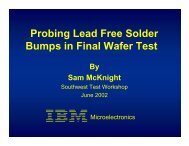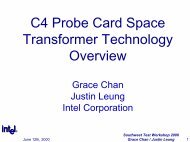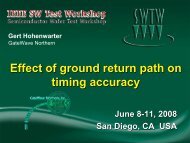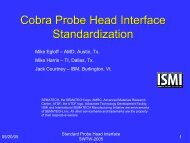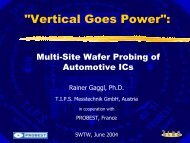(TFI ) Probes in Production - Semiconductor Wafer Test Workshop
(TFI ) Probes in Production - Semiconductor Wafer Test Workshop
(TFI ) Probes in Production - Semiconductor Wafer Test Workshop
You also want an ePaper? Increase the reach of your titles
YUMPU automatically turns print PDFs into web optimized ePapers that Google loves.
Chris Sullivan, John Hagios,<br />
Steve Duda, Sally Francis<br />
IBM Systems & Technology Group<br />
Essex Junction, Vermont<br />
Th<strong>in</strong> Film Interposer (<strong>TFI</strong> )<br />
<strong>Probes</strong> <strong>in</strong> <strong>Production</strong><br />
TM<br />
Challenges, Experiences,<br />
and Lessons Learned<br />
June 6, 2007
<strong>TFI</strong> <strong>Probes</strong> <strong>in</strong> <strong>Production</strong><br />
TM<br />
Overview<br />
• Background<br />
• Benefits<br />
– Why does IBM use <strong>TFI</strong>?<br />
• Challenges<br />
– Parallelism and Co-Planarity<br />
– Vacuum<br />
– Handl<strong>in</strong>g and Clean<strong>in</strong>g<br />
– Thermal Constra<strong>in</strong>ts<br />
– Retest Constra<strong>in</strong>ts<br />
• Experiences<br />
– “Channel 119 - The Crushed P<strong>in</strong> Issue”<br />
– “Channel 113 - The Hotspot Issue”<br />
– “When Processors Attack”<br />
• Summary<br />
June 6, 2007<br />
IEEE SW <strong>Test</strong> <strong>Workshop</strong> 2
<strong>TFI</strong> <strong>Probes</strong> <strong>in</strong> <strong>Production</strong><br />
TM<br />
Background<br />
• <strong>TFI</strong> probes were developed by IBM team members <strong>in</strong> Endicott,<br />
Yorktown Heights, Fishkill, and Burl<strong>in</strong>gton <strong>in</strong> the early 1990s<br />
• Pedestal substrates were developed by IBM Ceramic Packag<strong>in</strong>g <strong>in</strong><br />
Fishkill<br />
June 6, 2007<br />
IEEE SW <strong>Test</strong> <strong>Workshop</strong> 3
<strong>TFI</strong> <strong>Probes</strong> <strong>in</strong> <strong>Production</strong><br />
TM<br />
Background<br />
• <strong>Production</strong> use of <strong>TFI</strong> and pedestal probecards began <strong>in</strong> 1998 on<br />
MCM chips for the S/390 G5 ma<strong>in</strong>frame, on the IBM-designed LLCC<br />
wafer tester us<strong>in</strong>g Electroglas 3001 probers<br />
• Die Sizes:<br />
– 8x8mm<br />
thru 17x17mm<br />
• C4 Pitch:<br />
– 318um m<strong>in</strong><br />
• P<strong>in</strong>count:<br />
– ~ 1,600 max<br />
• Power @ <strong>Test</strong>:<br />
– ~ 40W max<br />
June 6, 2007<br />
IEEE SW <strong>Test</strong> <strong>Workshop</strong> 4
<strong>TFI</strong> <strong>Probes</strong> <strong>in</strong> <strong>Production</strong><br />
TM<br />
Background<br />
• <strong>TFI</strong> was migrated to the Teradyne J973 / TEL P-8XL platform for<br />
test<strong>in</strong>g the POWER4 processor <strong>in</strong> 2000<br />
June 6, 2007<br />
IEEE SW <strong>Test</strong> <strong>Workshop</strong> 5
<strong>TFI</strong> <strong>Probes</strong> <strong>in</strong> <strong>Production</strong><br />
TM<br />
Background<br />
• S<strong>in</strong>ce 2000, <strong>TFI</strong> is be<strong>in</strong>g used to test:<br />
– all zSeries ma<strong>in</strong>frame MCM processors/ASICs<br />
– all pSeries and iSeries server processors<br />
• <strong>TFI</strong> is used on 5 tester platforms:<br />
– LLCC, Teradyne J973, Teradyne UltraFlex, Advantest 66XX,<br />
Agilent 93000<br />
System z<br />
Systems i and p<br />
• Die Sizes:<br />
– 8x8 - 21x21mm<br />
• C4 Pitch:<br />
– 200um m<strong>in</strong><br />
• P<strong>in</strong>count:<br />
– ~ 7,800 max<br />
• Power @ <strong>Test</strong>:<br />
– ~ 400W max<br />
June 6, 2007<br />
z9 MCM<br />
p5 MCM<br />
IEEE SW <strong>Test</strong> <strong>Workshop</strong> 6
<strong>TFI</strong> <strong>Probes</strong> <strong>in</strong> <strong>Production</strong><br />
TM<br />
• Background<br />
• Benefits<br />
– Why does IBM use <strong>TFI</strong>?<br />
• Challenges<br />
– Parallelism and Co-Planarity<br />
– Vacuum<br />
– Handl<strong>in</strong>g and Clean<strong>in</strong>g<br />
– Thermal Constra<strong>in</strong>ts<br />
– Retest Constra<strong>in</strong>ts<br />
• Experiences<br />
– “Channel 119 - The Crushed P<strong>in</strong> Issue”<br />
– “Channel 113 - The Hotspot Issue”<br />
– “When Processors Attack”<br />
• Summary<br />
June 6, 2007<br />
IEEE SW <strong>Test</strong> <strong>Workshop</strong> 7
<strong>TFI</strong> <strong>Probes</strong> <strong>in</strong> <strong>Production</strong><br />
TM<br />
Why does IBM use <strong>TFI</strong>?<br />
Benefits<br />
• Power Delivery<br />
– low <strong>in</strong>ductance<br />
– DUT is closer to<br />
decoupl<strong>in</strong>g<br />
<strong>TFI</strong><br />
Cobra<br />
June 6, 2007<br />
IEEE SW <strong>Test</strong> <strong>Workshop</strong> 8
<strong>TFI</strong> <strong>Probes</strong> <strong>in</strong> <strong>Production</strong><br />
TM<br />
Benefits<br />
Why does IBM use <strong>TFI</strong>?<br />
• Power Delivery<br />
– Power/Ground planes built <strong>in</strong>to the pedestal allow for lateral<br />
current flow right up to the DUT<br />
– Capacitance of pedestal planes further enhance di/dt<br />
performance<br />
June 6, 2007<br />
IEEE SW <strong>Test</strong> <strong>Workshop</strong> 9
<strong>TFI</strong> <strong>Probes</strong> <strong>in</strong> <strong>Production</strong><br />
TM<br />
Why does IBM use <strong>TFI</strong>?<br />
• Thermal Performance<br />
– The <strong>TFI</strong> / Pedestal <strong>in</strong>terface<br />
is the closest test<br />
environment to “packagelevel”<br />
of any C4 wafer probe<br />
technology.<br />
• If a chip is prone to<br />
thermal runaway at<br />
package-level, it will<br />
behave similarly dur<strong>in</strong>g<br />
<strong>TFI</strong> test.<br />
Benefits<br />
<strong>TFI</strong><br />
Cobra<br />
June 6, 2007<br />
IEEE SW <strong>Test</strong> <strong>Workshop</strong> 10
<strong>TFI</strong> <strong>Probes</strong> <strong>in</strong> <strong>Production</strong><br />
TM<br />
Why does IBM use <strong>TFI</strong>?<br />
• Thermal Performance<br />
Benefits<br />
– If an over-current event happens, the C4 is the fuse, not the<br />
probe.<br />
<strong>TFI</strong><br />
Cobra<br />
June 6, 2007<br />
IEEE SW <strong>Test</strong> <strong>Workshop</strong> 11
<strong>TFI</strong> <strong>Probes</strong> <strong>in</strong> <strong>Production</strong><br />
TM<br />
Why does IBM use <strong>TFI</strong>?<br />
• Scalability<br />
Benefits<br />
– <strong>TFI</strong> probes are produced us<strong>in</strong>g photolithography, so:<br />
• Pitch, density, and asymmetry are not limited by fab process<br />
• Cost does not <strong>in</strong>crease as steeply for high-p<strong>in</strong>count probes<br />
June 6, 2007<br />
IEEE SW <strong>Test</strong> <strong>Workshop</strong> 12
<strong>TFI</strong> <strong>Probes</strong> <strong>in</strong> <strong>Production</strong><br />
TM<br />
Why does IBM use <strong>TFI</strong>?<br />
• Ma<strong>in</strong>tenance<br />
Benefits<br />
– Simple design<br />
– If a p<strong>in</strong> is damaged, it can be “plucked” easily without remov<strong>in</strong>g<br />
dies or disturb<strong>in</strong>g other p<strong>in</strong>s (though p<strong>in</strong>s cannot be replaced)<br />
June 6, 2007<br />
IEEE SW <strong>Test</strong> <strong>Workshop</strong> 13
<strong>TFI</strong> <strong>Probes</strong> <strong>in</strong> <strong>Production</strong><br />
TM<br />
• Background<br />
• Benefits<br />
– Why does IBM use <strong>TFI</strong>?<br />
• Challenges<br />
– Parallelism and Co-Planarity<br />
– Vacuum<br />
– Handl<strong>in</strong>g and Clean<strong>in</strong>g<br />
– Thermal Constra<strong>in</strong>ts<br />
– Retest Constra<strong>in</strong>ts<br />
• Experiences<br />
– “Channel 119 - The Crushed P<strong>in</strong> Issue”<br />
– “Channel 113 - The Hotspot Issue”<br />
– “When Processors Attack”<br />
• Summary<br />
June 6, 2007<br />
IEEE SW <strong>Test</strong> <strong>Workshop</strong> 14
<strong>TFI</strong> <strong>Probes</strong> <strong>in</strong> <strong>Production</strong><br />
TM<br />
Challenges<br />
• Parallelism and Co-Planarity<br />
– <strong>TFI</strong> is a rigid probe array<br />
• mak<strong>in</strong>g contact with wafer is difficult to impossible if the<br />
probe array and the wafer C4s are not co-planar, and parallel<br />
to each other.<br />
PARALLELISM<br />
CO-PLANARITY<br />
June 6, 2007<br />
IEEE SW <strong>Test</strong> <strong>Workshop</strong> 15
<strong>TFI</strong> <strong>Probes</strong> <strong>in</strong> <strong>Production</strong><br />
TM<br />
Challenges<br />
• Parallelism and Co-Planarity<br />
– Co-Planarity from probe to probe must be with<strong>in</strong> microns<br />
• re-discovered the “hard way”; illustrated later <strong>in</strong> Experiences<br />
section<br />
June 6, 2007<br />
IEEE SW <strong>Test</strong> <strong>Workshop</strong> 16
<strong>TFI</strong> <strong>Probes</strong> <strong>in</strong> <strong>Production</strong><br />
TM<br />
Challenges<br />
• Parallelism and Co-Planarity<br />
– In production test, all comb<strong>in</strong>ations of probecards and testers<br />
need to be <strong>in</strong>terchangeable and parallel<br />
June 6, 2007<br />
IEEE SW <strong>Test</strong> <strong>Workshop</strong> 17
<strong>TFI</strong> <strong>Probes</strong> <strong>in</strong> <strong>Production</strong><br />
TM<br />
Challenges<br />
• Parallelism and Co-Planarity<br />
– Parallelism tolerance w<strong>in</strong>dows (z-variation across die):<br />
• Cobra <strong>Probes</strong>: 50 - 100um<br />
• <strong>TFI</strong> <strong>Probes</strong>: 8 - 20um !<br />
– Levell<strong>in</strong>g procedure with the J973 testhead fixture was not<br />
accurate or repeatable enough to ma<strong>in</strong>ta<strong>in</strong> the <strong>TFI</strong> tolerance<br />
w<strong>in</strong>dow<br />
June 6, 2007<br />
IEEE SW <strong>Test</strong> <strong>Workshop</strong> 18
<strong>TFI</strong> <strong>Probes</strong> <strong>in</strong> <strong>Production</strong><br />
TM<br />
Challenges<br />
• Parallelism and Co-Planarity<br />
– IBM developed a procedure us<strong>in</strong>g the TEL prober look-up optics<br />
to “dial <strong>in</strong>” the J973 testhead levell<strong>in</strong>g us<strong>in</strong>g a “golden” standard<br />
probecard<br />
– The rigid and co-planar nature of the probe array (held <strong>in</strong> place<br />
under vacuum) gave us a very accurate measurement of probe<br />
parallelism<br />
June 6, 2007<br />
IEEE SW <strong>Test</strong> <strong>Workshop</strong> 19
<strong>TFI</strong> <strong>Probes</strong> <strong>in</strong> <strong>Production</strong><br />
TM<br />
Challenges<br />
• Parallelism and Co-Planarity<br />
– Illustration of planarization measurement<br />
process<br />
June 6, 2007<br />
IEEE SW <strong>Test</strong> <strong>Workshop</strong> 20
<strong>TFI</strong> <strong>Probes</strong> <strong>in</strong> <strong>Production</strong><br />
TM<br />
• Vacuum<br />
Why use vacuum?<br />
Challenges<br />
– Probehead needed to be th<strong>in</strong> to m<strong>in</strong>imize pedestal height<br />
– Quick <strong>in</strong>stallation and removal of probehead<br />
– Simple probehead design:<br />
• <strong>TFI</strong> foil, adhesive, mount<strong>in</strong>g plate<br />
• No screw-holes or crevices to trap chemical clean<strong>in</strong>g solution<br />
– Probers already need a steady, reliable vacuum supply<br />
June 6, 2007<br />
IEEE SW <strong>Test</strong> <strong>Workshop</strong> 21
<strong>TFI</strong> <strong>Probes</strong> <strong>in</strong> <strong>Production</strong><br />
TM<br />
• Vacuum<br />
Why use vacuum?<br />
Challenges<br />
– <strong>Probes</strong> are held tightly aga<strong>in</strong>st the pedestal, which prevents:<br />
• Extra impact force for “sagg<strong>in</strong>g” probes <strong>in</strong> the array center<br />
• Any micro-bonds between probes and C4s from pull<strong>in</strong>g and<br />
strecth<strong>in</strong>g the film dur<strong>in</strong>g separation<br />
June 6, 2007<br />
IEEE SW <strong>Test</strong> <strong>Workshop</strong> 22
<strong>TFI</strong> <strong>Probes</strong> <strong>in</strong> <strong>Production</strong><br />
TM<br />
• Vacuum<br />
Challenges<br />
– Vacuum l<strong>in</strong>es are routed through the prober to two places:<br />
• <strong>Test</strong>er-side of probecard when docked<br />
• Probecard load<strong>in</strong>g tray at front of prober<br />
June 6, 2007<br />
IEEE SW <strong>Test</strong> <strong>Workshop</strong> 23
<strong>TFI</strong> <strong>Probes</strong> <strong>in</strong> <strong>Production</strong><br />
TM<br />
• Vacuum<br />
Challenges<br />
– S<strong>in</strong>ce probecards need two<br />
vacuum <strong>in</strong>terface ports,<br />
m<strong>in</strong>iature check-valves are<br />
used <strong>in</strong> the probecard tube<br />
rout<strong>in</strong>g to prevent leak<strong>in</strong>g<br />
from the unused vacuum<br />
port<br />
June 6, 2007<br />
IEEE SW <strong>Test</strong> <strong>Workshop</strong> 24
<strong>TFI</strong> <strong>Probes</strong> <strong>in</strong> <strong>Production</strong><br />
TM<br />
• Handl<strong>in</strong>g and Clean<strong>in</strong>g<br />
Challenges<br />
– <strong>TFI</strong> probe electrical contact is very sensitive to foreign material<br />
contam<strong>in</strong>ation, especially between the probe and pedestal<br />
– The probe has little to no lateral “scrub” dur<strong>in</strong>g contact to break<br />
through any FM<br />
June 6, 2007<br />
IEEE SW <strong>Test</strong> <strong>Workshop</strong> 25
<strong>TFI</strong> <strong>Probes</strong> <strong>in</strong> <strong>Production</strong><br />
TM<br />
• Handl<strong>in</strong>g and Clean<strong>in</strong>g<br />
Challenges<br />
– FM contam<strong>in</strong>ation has been and cont<strong>in</strong>ues to be the biggest<br />
source of failed <strong>TFI</strong> test setups<br />
– Sk<strong>in</strong> flakes were found to be the primary culprit<br />
June 6, 2007<br />
IEEE SW <strong>Test</strong> <strong>Workshop</strong> 26
<strong>TFI</strong> <strong>Probes</strong> <strong>in</strong> <strong>Production</strong><br />
TM<br />
• Handl<strong>in</strong>g and Clean<strong>in</strong>g<br />
Challenges<br />
– The 4-<strong>in</strong>ch plastic wafer<br />
conta<strong>in</strong>ers used to store <strong>TFI</strong><br />
probes are non-ESD<br />
– The charge built up from<br />
open<strong>in</strong>g the conta<strong>in</strong>er may be<br />
attract<strong>in</strong>g FM to the probes<br />
June 6, 2007<br />
IEEE SW <strong>Test</strong> <strong>Workshop</strong> 27
<strong>TFI</strong> <strong>Probes</strong> <strong>in</strong> <strong>Production</strong><br />
TM<br />
• Handl<strong>in</strong>g and Clean<strong>in</strong>g<br />
Challenges<br />
– Options are be<strong>in</strong>g evaluated to solution the FM issue:<br />
• Ionizers and gloves at probe <strong>in</strong>spection stations<br />
• Ionizers at testers dur<strong>in</strong>g probe load<strong>in</strong>g<br />
• ESD conta<strong>in</strong>ers<br />
• UV microscope <strong>in</strong>spection<br />
• Auto-load<strong>in</strong>g cartridges (like a CD changer)<br />
June 6, 2007<br />
IEEE SW <strong>Test</strong> <strong>Workshop</strong> 28
<strong>TFI</strong> <strong>Probes</strong> <strong>in</strong> <strong>Production</strong><br />
TM<br />
• Handl<strong>in</strong>g and Clean<strong>in</strong>g<br />
Challenges<br />
– The sculpted shape of the <strong>TFI</strong> p<strong>in</strong> does not allow for standard<br />
probe polish<strong>in</strong>g techniques used at <strong>in</strong>-situ clean<strong>in</strong>g<br />
– <strong>TFI</strong> probes must be removed from the tester at each clean<strong>in</strong>g<br />
cycle to be sent for off-l<strong>in</strong>e chemical clean<strong>in</strong>g<br />
June 6, 2007<br />
IEEE SW <strong>Test</strong> <strong>Workshop</strong> 29
<strong>TFI</strong> <strong>Probes</strong> <strong>in</strong> <strong>Production</strong><br />
TM<br />
• Handl<strong>in</strong>g and Clean<strong>in</strong>g<br />
Challenges<br />
– Off-l<strong>in</strong>e chemical clean<strong>in</strong>g is effective, but significantly <strong>in</strong>creases<br />
tool down-time, and requires at least 1 spare probe per tool<br />
– <strong>Probes</strong> are often allowed to run longer than the allowed clean<strong>in</strong>g<br />
cycle to avoid re-setup of a tool, dim<strong>in</strong>ish<strong>in</strong>g probe life and<br />
risk<strong>in</strong>g product damage<br />
June 6, 2007<br />
IEEE SW <strong>Test</strong> <strong>Workshop</strong> 30
<strong>TFI</strong> <strong>Probes</strong> <strong>in</strong> <strong>Production</strong><br />
TM<br />
• Handl<strong>in</strong>g and Clean<strong>in</strong>g<br />
Challenges<br />
– Options for allow<strong>in</strong>g <strong>in</strong>-situ <strong>TFI</strong> clean<strong>in</strong>g:<br />
• Alter<strong>in</strong>g metallurgy and tip shape to allow abrasive clean<strong>in</strong>g<br />
• Chemical clean<strong>in</strong>g station <strong>in</strong>side prober<br />
• Auto-load<strong>in</strong>g/unload<strong>in</strong>g cartridge <strong>in</strong>side prober<br />
June 6, 2007<br />
IEEE SW <strong>Test</strong> <strong>Workshop</strong> 31
<strong>TFI</strong> <strong>Probes</strong> <strong>in</strong> <strong>Production</strong><br />
TM<br />
• Thermal Constra<strong>in</strong>ts<br />
Challenges<br />
– <strong>TFI</strong> probes ma<strong>in</strong>ta<strong>in</strong> very stable X-Y position over wide<br />
temperature range (-10°C to 75°C production, 90°C lab)<br />
– However, <strong>TFI</strong> probes are susceptible to contact failure from<br />
drastic thermal gradients with<strong>in</strong> a die through vertical expansion<br />
(illustrated <strong>in</strong> Experiences section)<br />
June 6, 2007<br />
IEEE SW <strong>Test</strong> <strong>Workshop</strong> 32
<strong>TFI</strong> <strong>Probes</strong> <strong>in</strong> <strong>Production</strong><br />
TM<br />
• Retest Constra<strong>in</strong>ts<br />
Challenges<br />
– <strong>TFI</strong> probe tips are sculpted<br />
to puncture through the t<strong>in</strong>oxide<br />
on a C4 with m<strong>in</strong>imal<br />
force<br />
– After prob<strong>in</strong>g, the<br />
impression on the C4 is<br />
permanent. Each time a die<br />
is probed, a new impression<br />
is made.<br />
June 6, 2007<br />
IEEE SW <strong>Test</strong> <strong>Workshop</strong> 33
<strong>TFI</strong> <strong>Probes</strong> <strong>in</strong> <strong>Production</strong><br />
TM<br />
• Retest Constra<strong>in</strong>ts<br />
Challenges<br />
– Though parallelism and co-planarity are held with<strong>in</strong> tight<br />
w<strong>in</strong>dows, contact becomes more difficult with each re-test.<br />
June 6, 2007<br />
IEEE SW <strong>Test</strong> <strong>Workshop</strong> 34
<strong>TFI</strong> <strong>Probes</strong> <strong>in</strong> <strong>Production</strong><br />
TM<br />
• Retest Constra<strong>in</strong>ts<br />
Challenges<br />
– It was found that a 3 rd test pass yielded too many contact fails<br />
and risked permanent deformation of the C4s.<br />
– <strong>Test</strong> rout<strong>in</strong>g procedures were altered to mandate a reflow step<br />
after the 2 nd test pass.<br />
June 6, 2007<br />
IEEE SW <strong>Test</strong> <strong>Workshop</strong> 35
<strong>TFI</strong> <strong>Probes</strong> <strong>in</strong> <strong>Production</strong><br />
TM<br />
• Background<br />
• Benefits<br />
– Why does IBM use <strong>TFI</strong>?<br />
• Challenges<br />
– Parallelism and Co-Planarity<br />
– Vacuum<br />
– Handl<strong>in</strong>g and Clean<strong>in</strong>g<br />
– Thermal Constra<strong>in</strong>ts<br />
– Retest Constra<strong>in</strong>ts<br />
• Experiences<br />
– “Channel 119 - The Crushed P<strong>in</strong> Issue”<br />
– “Channel 113 - The Hotspot Issue”<br />
– “When Processors Attack”<br />
• Summary<br />
June 6, 2007<br />
IEEE SW <strong>Test</strong> <strong>Workshop</strong> 36
<strong>TFI</strong> <strong>Probes</strong> <strong>in</strong> <strong>Production</strong><br />
TM<br />
Experiences<br />
• “Channel 119 – The Crushed P<strong>in</strong> Issue”<br />
– After several weeks of successful test<strong>in</strong>g on POWER5+ earlyuser<br />
hardware (EUH), a rash of contact issues started<br />
happen<strong>in</strong>g, and worsened over time<br />
– The contact fails were always with only a few (1-3) signals, and<br />
Channel 119 was by far the most common<br />
– There was no evident pattern isolat<strong>in</strong>g specific testers,<br />
probecards, or product v<strong>in</strong>tages<br />
June 6, 2007<br />
IEEE SW <strong>Test</strong> <strong>Workshop</strong> 37
<strong>TFI</strong> <strong>Probes</strong> <strong>in</strong> <strong>Production</strong><br />
TM<br />
Experiences<br />
• “Channel 119 – The Crushed P<strong>in</strong> Issue”<br />
– Inspection of impressions on the wafer did not reveal any<br />
evidence of light-prob<strong>in</strong>g, or on the C4 for Channel 119<br />
– No evidence of <strong>TFI</strong> probe damage was observed under standard<br />
microscope <strong>in</strong>spection<br />
June 6, 2007<br />
IEEE SW <strong>Test</strong> <strong>Workshop</strong> 38
<strong>TFI</strong> <strong>Probes</strong> <strong>in</strong> <strong>Production</strong><br />
TM<br />
Experiences<br />
• “Channel 119 – The Crushed P<strong>in</strong> Issue”<br />
– Dur<strong>in</strong>g further “micro” <strong>in</strong>spection of the fail<strong>in</strong>g C4 hitmark on the<br />
wafer, <strong>in</strong>dex<strong>in</strong>g from site to site revealed a deep C4 impression<br />
on a non-functional, partial site<br />
June 6, 2007<br />
IEEE SW <strong>Test</strong> <strong>Workshop</strong> 39
<strong>TFI</strong> <strong>Probes</strong> <strong>in</strong> <strong>Production</strong><br />
TM<br />
Experiences<br />
• “Channel 119 – The Crushed P<strong>in</strong> Issue”<br />
– IBM does not use the product C4 image for partial sites on the<br />
wafer edges<br />
June 6, 2007<br />
IEEE SW <strong>Test</strong> <strong>Workshop</strong> 40
<strong>TFI</strong> <strong>Probes</strong> <strong>in</strong> <strong>Production</strong><br />
TM<br />
Experiences<br />
• “Channel 119 – The Crushed P<strong>in</strong> Issue”<br />
– Closer <strong>in</strong>spection of a fail<strong>in</strong>g <strong>TFI</strong> probe revealed uniform<br />
impressions <strong>in</strong> the film<br />
June 6, 2007<br />
IEEE SW <strong>Test</strong> <strong>Workshop</strong> 41
<strong>TFI</strong> <strong>Probes</strong> <strong>in</strong> <strong>Production</strong><br />
TM<br />
Experiences<br />
• “Channel 119 – The Crushed P<strong>in</strong> Issue”<br />
– An overlay of the probe array on data for the C4 plat<strong>in</strong>g mask<br />
revealed that only the few fail<strong>in</strong>g signals were hitt<strong>in</strong>g C4s on the<br />
“partial site”<br />
June 6, 2007<br />
IEEE SW <strong>Test</strong> <strong>Workshop</strong> 42
<strong>TFI</strong> <strong>Probes</strong> <strong>in</strong> <strong>Production</strong><br />
TM<br />
Experiences<br />
• “Channel 119 – The Crushed P<strong>in</strong> Issue”<br />
– The impressions for Ch. 119 did not look lighter because the<br />
polyimide film was strong enough keep the flattened probes from<br />
contact<strong>in</strong>g the pedestal under load!<br />
June 6, 2007<br />
IEEE SW <strong>Test</strong> <strong>Workshop</strong> 43
<strong>TFI</strong> <strong>Probes</strong> <strong>in</strong> <strong>Production</strong><br />
TM<br />
Experiences<br />
• “Channel 119 – The Crushed P<strong>in</strong> Issue”<br />
– Lesson Learned:<br />
• Use the die mapp<strong>in</strong>g feature on the prober!<br />
June 6, 2007<br />
IEEE SW <strong>Test</strong> <strong>Workshop</strong> 44
<strong>TFI</strong> <strong>Probes</strong> <strong>in</strong> <strong>Production</strong><br />
TM<br />
• Background<br />
• Benefits<br />
– Why does IBM use <strong>TFI</strong>?<br />
• Challenges<br />
– Parallelism and Co-Planarity<br />
– Vacuum<br />
– Handl<strong>in</strong>g and Clean<strong>in</strong>g<br />
– Thermal Constra<strong>in</strong>ts<br />
– Retest Constra<strong>in</strong>ts<br />
• Experiences<br />
– “Channel 119 - The Crushed P<strong>in</strong> Issue”<br />
– “Channel 113 - The Hotspot Issue”<br />
– “When Processors Attack”<br />
• Summary<br />
June 6, 2007<br />
IEEE SW <strong>Test</strong> <strong>Workshop</strong> 45
<strong>TFI</strong> <strong>Probes</strong> <strong>in</strong> <strong>Production</strong><br />
TM<br />
Experiences<br />
• “Channel 113 – The Hotspot Issue”<br />
– <strong>Test</strong> eng<strong>in</strong>eers began notic<strong>in</strong>g high fallout on POWER5+ for<br />
faster chips on the 2 nd test pass (70°C). An unwelcome effect<br />
was revealed dur<strong>in</strong>g the high-corner voltage screen ….<br />
June 6, 2007<br />
IEEE SW <strong>Test</strong> <strong>Workshop</strong> 46
<strong>TFI</strong> <strong>Probes</strong> <strong>in</strong> <strong>Production</strong><br />
TM<br />
Experiences<br />
• “Channel 113 – The Hotspot Issue”<br />
– IBM uses Built-In Self <strong>Test</strong> (BIST) <strong>in</strong> our test methodology so:<br />
• Not all signals need to be probed at wafer<br />
• <strong>Test</strong>ers don’t need as many signal cards<br />
June 6, 2007<br />
IEEE SW <strong>Test</strong> <strong>Workshop</strong> 47
<strong>TFI</strong> <strong>Probes</strong> <strong>in</strong> <strong>Production</strong><br />
TM<br />
Experiences<br />
• “Channel 113 – The Hotspot Issue”<br />
– The chip has the two logical cores on the top 3 rd of the die, and<br />
the L2 arrays on the right and bottom edges<br />
June 6, 2007<br />
IEEE SW <strong>Test</strong> <strong>Workshop</strong> 48
<strong>TFI</strong> <strong>Probes</strong> <strong>in</strong> <strong>Production</strong><br />
TM<br />
Experiences<br />
• “Channel 113 – The Hotspot Issue”<br />
– On faster dies, a thermal gradient developed dur<strong>in</strong>g this voltage<br />
screen, caus<strong>in</strong>g one signal <strong>in</strong> the corner to lose contact<br />
June 6, 2007<br />
IEEE SW <strong>Test</strong> <strong>Workshop</strong> 49
<strong>TFI</strong> <strong>Probes</strong> <strong>in</strong> <strong>Production</strong><br />
TM<br />
Experiences<br />
• “Channel 113 – The Hotspot Issue”<br />
– The solution was to build <strong>in</strong> a pull-up on that signal <strong>in</strong> the next<br />
revision of the chip design, s<strong>in</strong>ce it only needed to be <strong>in</strong> a certa<strong>in</strong><br />
state dur<strong>in</strong>g the screen<br />
– To test older product, the chuck temperature had to be lowered<br />
by 15°C so the cores didn’t get as hot<br />
June 6, 2007<br />
IEEE SW <strong>Test</strong> <strong>Workshop</strong> 50
<strong>TFI</strong> <strong>Probes</strong> <strong>in</strong> <strong>Production</strong><br />
TM<br />
Experiences<br />
• “Channel 113 – The Hotspot Issue”<br />
– Us<strong>in</strong>g a prober with a Liquid Thermal Interface (LTI) chuck<br />
would have likely solved this issue, but was not qualified for<br />
production at the time<br />
June 6, 2007<br />
IEEE SW <strong>Test</strong> <strong>Workshop</strong> 51
<strong>TFI</strong> <strong>Probes</strong> <strong>in</strong> <strong>Production</strong><br />
TM<br />
Experiences<br />
• “Channel 113 – The Hotspot Issue”<br />
– Lesson Learned:<br />
• Don’t mix with <strong>TFI</strong> with thermal gradients across a die!<br />
June 6, 2007<br />
IEEE SW <strong>Test</strong> <strong>Workshop</strong> 52
<strong>TFI</strong> <strong>Probes</strong> <strong>in</strong> <strong>Production</strong><br />
TM<br />
• Background<br />
• Benefits<br />
– Why does IBM use <strong>TFI</strong>?<br />
• Challenges<br />
– Parallelism and Co-Planarity<br />
– Vacuum<br />
– Handl<strong>in</strong>g and Clean<strong>in</strong>g<br />
– Thermal Constra<strong>in</strong>ts<br />
– Retest Constra<strong>in</strong>ts<br />
• Experiences<br />
– “Channel 119 - The Crushed P<strong>in</strong> Issue”<br />
– “Channel 113 - The Hotspot Issue”<br />
– “When Processors Attack”<br />
• Summary<br />
June 6, 2007<br />
IEEE SW <strong>Test</strong> <strong>Workshop</strong> 53
<strong>TFI</strong> <strong>Probes</strong> <strong>in</strong> <strong>Production</strong><br />
TM<br />
Experiences<br />
• “When Processors Attack”<br />
– The Early-User Hardware (EUH) phase of develop<strong>in</strong>g a new chip<br />
design is usually an “eventful” period on the test floor<br />
– The follow<strong>in</strong>g are samples of the sacrifices our probes have<br />
made to protect our servers….<br />
June 6, 2007<br />
IEEE SW <strong>Test</strong> <strong>Workshop</strong> 54
<strong>TFI</strong> <strong>Probes</strong> <strong>in</strong> <strong>Production</strong><br />
TM<br />
Experiences<br />
• “When Processors Attack”<br />
– Unfortunately, these are all different probes<br />
June 6, 2007<br />
IEEE SW <strong>Test</strong> <strong>Workshop</strong> 55
<strong>TFI</strong> <strong>Probes</strong> <strong>in</strong> <strong>Production</strong><br />
TM<br />
Experiences<br />
• “When Processors Attack”<br />
June 6, 2007<br />
IEEE SW <strong>Test</strong> <strong>Workshop</strong> 56
<strong>TFI</strong> <strong>Probes</strong> <strong>in</strong> <strong>Production</strong><br />
TM<br />
Experiences<br />
• “When Processors Attack”<br />
June 6, 2007<br />
IEEE SW <strong>Test</strong> <strong>Workshop</strong> 57
<strong>TFI</strong> <strong>Probes</strong> <strong>in</strong> <strong>Production</strong><br />
TM<br />
Experiences<br />
• “When Processors Attack”<br />
June 6, 2007<br />
IEEE SW <strong>Test</strong> <strong>Workshop</strong> 58
<strong>TFI</strong> <strong>Probes</strong> <strong>in</strong> <strong>Production</strong><br />
TM<br />
Experiences<br />
• “When Processors Attack”<br />
June 6, 2007<br />
IEEE SW <strong>Test</strong> <strong>Workshop</strong> 59
<strong>TFI</strong> <strong>Probes</strong> <strong>in</strong> <strong>Production</strong><br />
TM<br />
• Background<br />
• Benefits<br />
– Why does IBM use <strong>TFI</strong>?<br />
• Challenges<br />
– Parallelism and Co-Planarity<br />
– Vacuum<br />
– Handl<strong>in</strong>g and Clean<strong>in</strong>g<br />
– Thermal Constra<strong>in</strong>ts<br />
– Retest Constra<strong>in</strong>ts<br />
• Experiences<br />
– “Channel 119 - The Crushed P<strong>in</strong> Issue”<br />
– “Channel 113 - The Hotspot Issue”<br />
– “When Processors Attack”<br />
• Summary<br />
June 6, 2007<br />
IEEE SW <strong>Test</strong> <strong>Workshop</strong> 60
<strong>TFI</strong> <strong>Probes</strong> <strong>in</strong> <strong>Production</strong><br />
TM<br />
Summary<br />
• <strong>TFI</strong> is not a very “forgiv<strong>in</strong>g” probe technology<br />
• <strong>TFI</strong> has demanded significant effort and resources make it a<br />
production-worthy prob<strong>in</strong>g solution<br />
• IBM has developed significant <strong>in</strong>frastructure around <strong>TFI</strong> to br<strong>in</strong>g it<br />
to the production test floor<br />
but…<br />
• <strong>TFI</strong> has enabled IBM’s test capability to match the <strong>in</strong>creas<strong>in</strong>gly high<br />
performance and complexity of its server and ma<strong>in</strong>frame<br />
processors<br />
• <strong>TFI</strong> has enabled IBM to ga<strong>in</strong> and ma<strong>in</strong>ta<strong>in</strong> its performance lead <strong>in</strong><br />
the high-end server market<br />
June 6, 2007<br />
IEEE SW <strong>Test</strong> <strong>Workshop</strong> 61
<strong>TFI</strong> <strong>Probes</strong> <strong>in</strong> <strong>Production</strong><br />
TM<br />
Acknowledgements<br />
• Special thanks to the <strong>TFI</strong> Eng<strong>in</strong>eer<strong>in</strong>g and Support teams for their<br />
contributions to this paper:<br />
John Hagios<br />
Steve Duda<br />
Sally Francis<br />
Sam McKnight<br />
Jack Courtney<br />
Phil Dies<strong>in</strong>g<br />
Mike Ingalls<br />
IBM<br />
IBM<br />
IBM<br />
IBM<br />
IBM<br />
IBM<br />
IBM<br />
June 6, 2007<br />
IEEE SW <strong>Test</strong> <strong>Workshop</strong> 62


